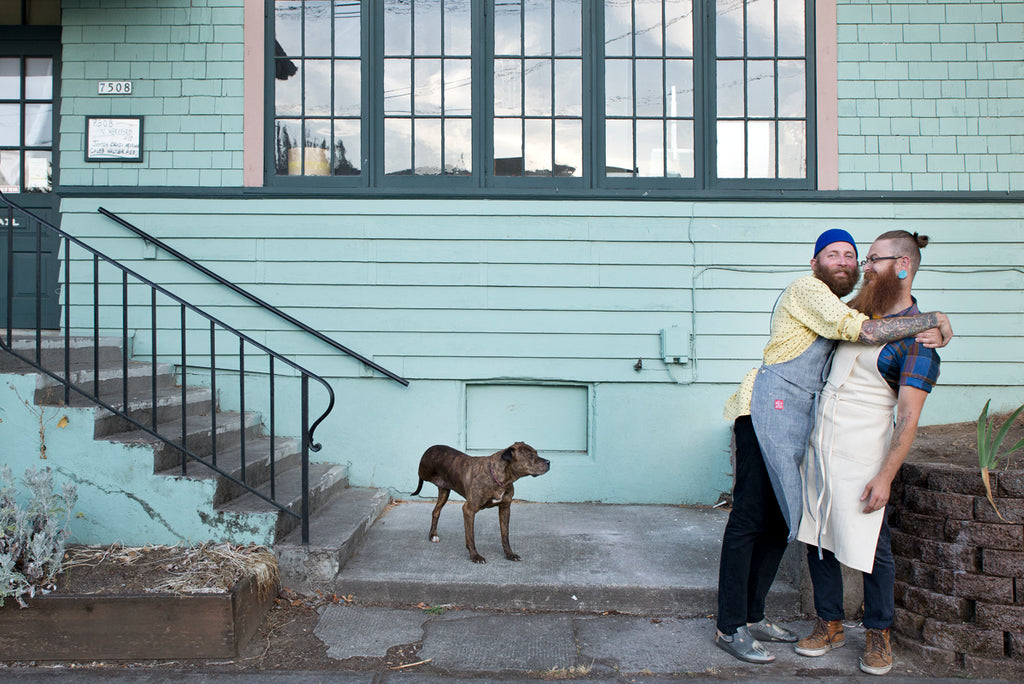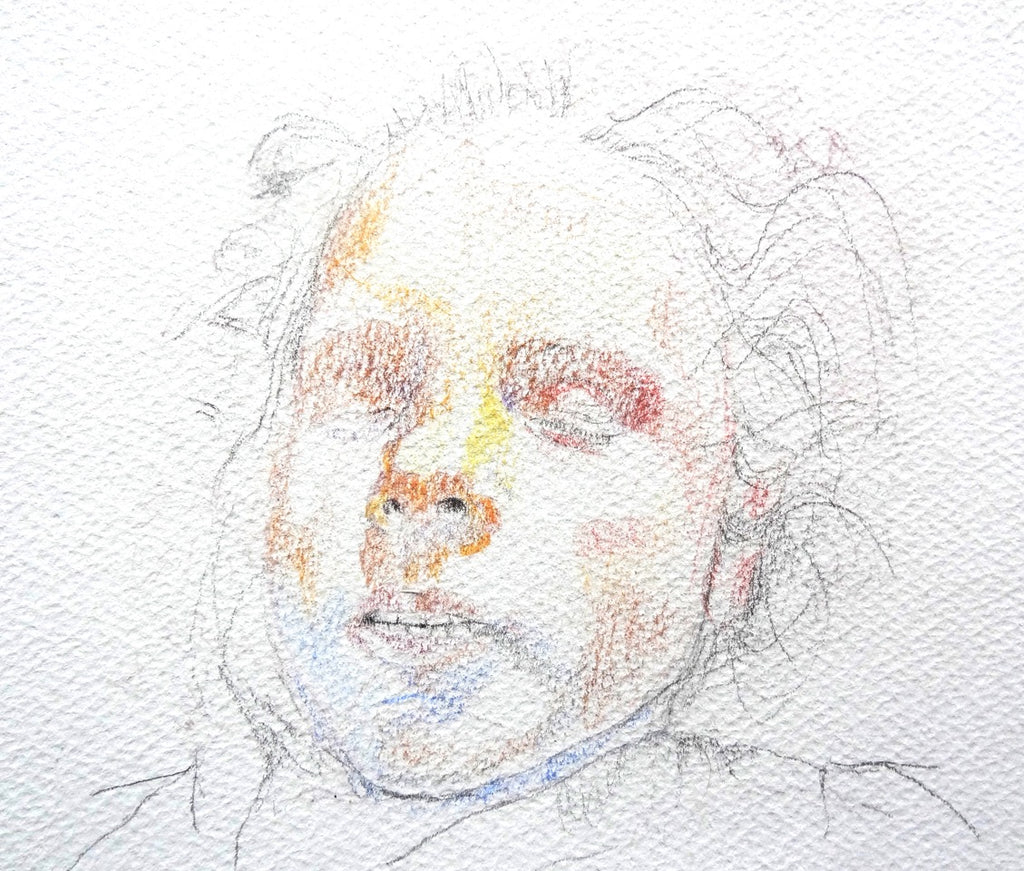Portraits Light, Dark & Ghostly: A visit with Caleb Walter Reed
Posted on 30 July 2015
We recently visited artists Caleb Walter Reed and Justin Craig Morgan in their beautiful St. Johns home studio to shoot our fresh Summer Apron lookbook. Afterward we chatted with Caleb about his creative process and distinctive style of portraiture.
You can see more of Caleb's haunting work online and in person at Alder & Co. in Portland, and keep up with Justin on Tumblr.

You have a background in painting and now work in pastel and colored pencil. How did that transition happen?
When I got my degree from Pratt in NY in around 2007, I worked in oil paint as basically my only medium. I started using the pencils because of the detail I could get with portraits, which is almost solely how I work. That detail I couldn’t get with the oil paint. And it’s also a much quicker result, a little more gratifying. I also have a great love of paper. Before, I was oil painting on paper and the result was pretty, but there’s something about the dry media on paper that’s very satisfying for me.
What about paper do you love?
There are so many kinds! So many textures, and subtle colors that end up being part of the drawing. The background playing with the actual subject. And it’s much more portable. I love how it looks framed. It’s all around - for me - a more versatile surface. Whether it’s a piece of paper that’s super super light and flimsy or a thick heavy pressed watercolor paper. There’s such a variety.
I also write, and I write on a typewriter - I know, I know, it’s so cliche. So there’s also a love of paper there in a different capacity. I love sending letters, and I love stationery. There’s an intersection of those loves in how I work.

How would you describe the work you do?
Well, they’re portraits. They’re basically heads that suspend in space, there’s never an environment in which the head or portrait exists. It’s just something I’ve never done it and can’t see myself wanting to. The heads are just on their own, no back ground, no foreground, just the head. Usually severed at the head (sometimes literally), sometimes at the shoulder. And usually in a composition where the head is almost falling off the paper. They’re usually sad, or ghostly, or defeated. I work from life and photographs, and from sketches. Maybe 30% of the work I do are commissions. For instance I’m doing two portraits of children, and all the commissions are from photographs.

How does that sadness or darker feeling translate in commissioned work?
I usually ask for a photograph or selection of them, and [my choice] is always a photo where the subject is aloof or caught off guard in a way. I never want to paint someone smiling or looking directly at the camera. There’s a distance or disconnection. I can’t shy away from that. Several times people have gotten the piece and said “Wow you made my wife look really sad” - my people always look like ghosts.
Do you think that sadness is normally lacking in portraits?
A lot of it is too straightforward, yes. A lot of it isn’t about pathos, or an artist working in tune with their vision or drive. I don’t mean anyone one specific, but in general I see a lot of portraits that are really stagnant. And that’s a reason a lot of people like to get commissions from me, because it isn’t just a happy smiling face, it’s something a little bit darker. For me there has to be an element of the artist’s unusual perception of this person, who you’ve known your whole life and they don’t know at all. There’s a mysteriousness that I want to be obvious.
How do you find or choose your own subjects?
Honestly a vast majority are self portraits! That’s just because I’m available 24/7. I can pose myself how I want. If it’s not me, it’s typically friends. And trolling the dark corners of the internet for photographs, going down rabbit holes, finding kind of forgotten portraits of people that were probably posted a decade ago, deep deep in the depths, and reimagining those photographs into portraits. There’s also an element of when I find those I combine faces. Making a new face out of multiple found faces.

What does your workspace look like?
I work in our home. We live in a giant giant space in St. Johns, and my partner and I both have a separate studio area. Mine is bigger (haha). But that’s because he works so much differently than I do. I have 10 things going on at once and he has one! So it’s two giant tables covered with paper and pencils, in the corner of our living space.
How do you and Justin work? Are your creative processes independent?
We inspire each other for sure. I know he’s inspired me a lot. He paints icons in a traditional Byzantine style, but in his own way. There was a point when he first moved to Portland a few years ago when I started drawing all my portraits as saints and haloed figures. I was writing a lot of poetry at the time and he started basing some of his icons on my writing. At that point we were living in a much more close quartered space, so it’s something of an inevitability that there will be overlap.

What do you need in order to hit a good flow?
Well, I do like to have a beer while I work. I like to have a little alcohol, it keeps the momentum up. I have ADD so it helps with focus. That’s why I have 10 things going at once! If I can sit down with a piece for three hours a night, with a few beers, I’ll feel like I’ve gotten into the flow and conquered something. Some artists really work for hours and hours, but for a lot of artists including myself, it’s harder to do that. Especially when you work a full eight hour day, my commute alone is two or three hours. So getting three hours of work a night is an accomplishment for me.
How do you know when you’re done?
I don’t, I guess. I naturally reach a stopping point. I don’t know if they’re ever finished, it’s more about reaching the point where I don’t want to work on it any more and it’s time to move on to the next thing. But it’s the point where I feel like the piece is ready to go out into the world, or my website. It’s never a “Wow, this is Done” feeling.
So how do you gauge whether it’s ready for the internet or a larger audience?
I very rarely sell work that isn’t commissioned, so as far as an audience goes… it’s hard. We live in an age where conceptual art is very important and seen as really relevant, and portraiture is kind of archaic and more decorative. So it’s hard, I don’t know who I’m working for besides myself, and I’m hoping that it will transcend somehow. It’s something you have to keep asking yourself. Who do I want to reach with this piece? A gallery director? My friends? It’s an ongoing conversation.

How often do you clean your workspace?
I keep it pretty clean. That’s another thing that’s so good about pencils as a medium. Compared to oil paint it’s so easy to keep clean and not waste, or ruin an expensive brush… So my space is always kind of tidy. I like my pencils all arranged by color, and sharpened before I go to bed. It makes it easier to visualize what a piece needs because my work is really about color, the color is focal and having them arranged the way I do (it isn’t RGB or visible spectrum) it’s skin tones and hair colors… and I see that in the way I have them arranged. It’s not a beautiful arrangement, I wish I could just do visible spectrum, that’d be prettier. I have about 100 pencils that are flesh tones and they all look the same, but I do like having them as gradient as possible.
Any people whose processes or work especially inspire you?
Many! I love Egon Schiele, I keep his books open all around the space. Jenny Saville - oil painter from England. Big massive pictures with tons and tons of skin and folds, and cascading flesh. My brother in New York is a painter who I find totally inspiring. He’s incredibly prolific, and also a figurative painter. And I’m also very much into fashion, and inspired by a couple designers who inspire my color palate. It’s a pretty wide range. I love Henrik Vibscov. I love Walter van Beirendonck. He’s cool! It’s a lot about color, and patterns. My portraits are delicate and kind of barely-there, but there’s always an influence of color that I need to have.
The treatment of color and pattern, those are the cornerstones of how I interpret figures. Anatomy, form, yes it’s important, but that’s not an obsession of mine. It does come down to all the colors in an eyeball, not a perfect nose.
Do you have a desired impact that your work would have on a viewer?
I think that any time you do a portrait you want to evoke an introspective experience. I want someone to look at one and see that there’s something very sad and lost, and pitiful, about these figures.
So you like evoking open ended questions?
Yes absolutely. Why are they barely there? What are they missing? I have to ask myself “Why am I so satisfied with these figures being between existence and being ghosts?” I like not knowing myself. They’re somewhere between the corporeal world and the aether.

Does that bridge into fantasy for you?
I wouldn’t say no. I love fantasy. When I was doing the saints, those were odd timeless beings that harken a feeling or religious quality, but they’re not at the same time. In some of the new drawings the figures have beards that kind of cascade and become strange amorphous parts of their faces. So there’s definitely a fantastical element that I want to push even further.
Do you have any exciting work or projects coming up?
Yes! We just moved into our new space in June and it’s basically quadrupled our room. I haven’t had this much space in kind of… ever! We just settled in and we’re just starting to get prolific again. So I’d like to do something really big, which is something new for me. Maybe a large scale piece with multiple figures interacting with each other, though still in space and floating. Which is something I’ve never done! I think it’s time to explore that, and push it.
Large scale drawing is so different from painting! It naturally lends itself to smaller work. Do you think that will be an easy transition?
Exactly. You can’t just load up a big brush with a lot of paint and go. Drawing is self-limiting, so working large is hard but exciting. This will be very tedious and will test my ADD to the max, but we’ll see! In the meantime, I’m still working on smaller portraits. I have maybe four going right now. It’s typically one hour on one, then on to the next one, maybe one more and then calling it a night.